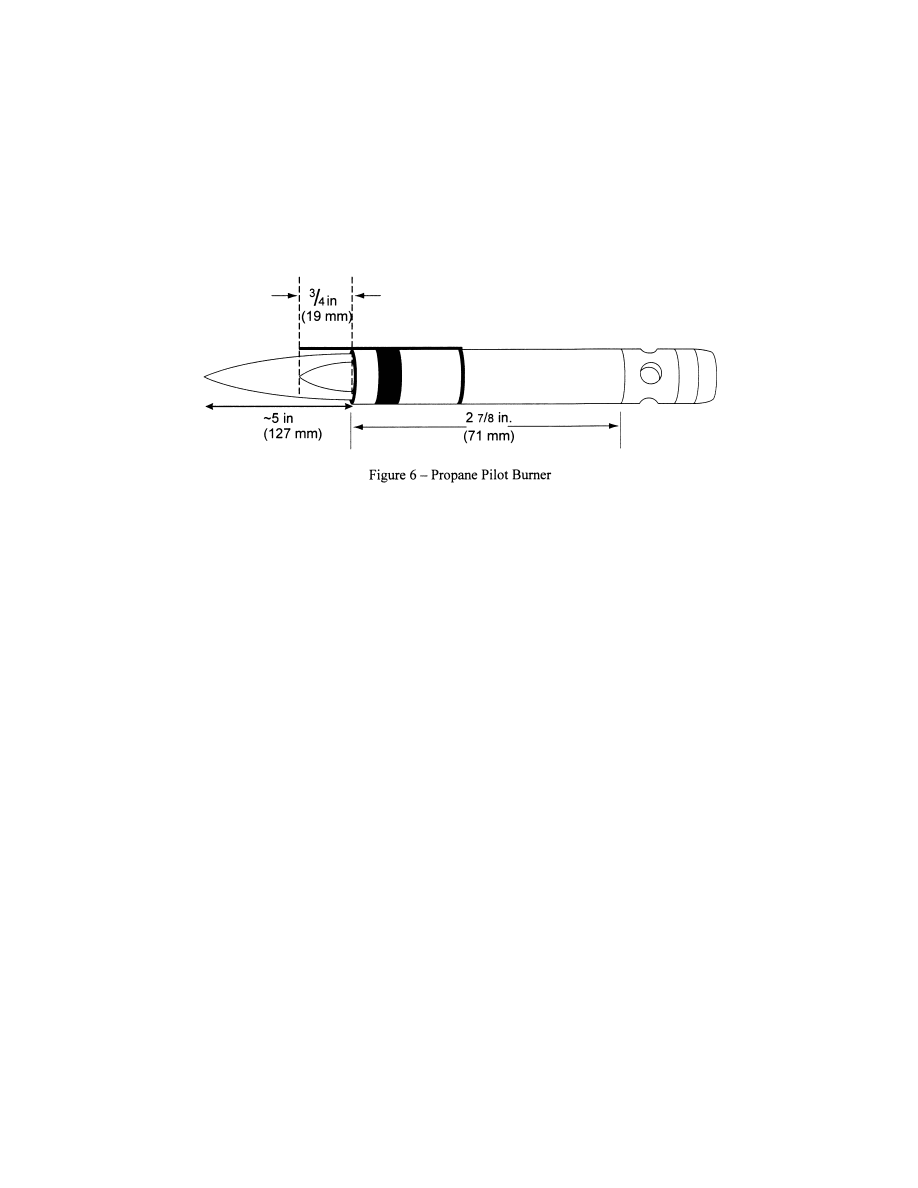
425
Federal Aviation Administration, DOT
Pt. 25, App. F
(5)
Thermocouples.
Install a 24 American
Wire Gauge (AWG) Type K (Chromel-Alumel)
thermocouple in the test chamber for tem-
perature monitoring. Insert it into the
chamber through a small hole drilled
through the back of the chamber. Place the
thermocouple so that it extends 11 inches
(279 mm) out from the back of the chamber
wall, 11
1
⁄
2
inches (292 mm) from the right side
of the chamber wall, and is 2 inches (51 mm)
below the radiant panel. The use of other
thermocouples is optional.
(6)
Calorimeter.
The calorimeter must be a
one-inch cylindrical water-cooled, total heat
flux density, foil type Gardon Gage that has
a range of 0 to 5 BTU/ft
2
-second (0 to 5.7
Watts/cm
2
).
(7)
Calorimeter calibration specification and
procedure.
(i)
Calorimeter specification.
(A) Foil diameter must be 0.25
±
0.005 inches
(6.35
±
0.13 mm).
(B) Foil thickness must be 0.0005
±
0.0001
inches (0.013
±
0.0025 mm).
(C) Foil material must be thermocouple
grade Constantan.
(D) Temperature measurement must be a
Copper Constantan thermocouple.
(E) The copper center wire diameter must
be 0.0005 inches (0.013 mm).
(F) The entire face of the calorimeter must
be lightly coated with ‘‘Black Velvet’’ paint
having an emissivity of 96 or greater.
(ii)
Calorimeter calibration.
(A) The calibra-
tion method must be by comparison to a like
standardized transducer.
(B) The standardized transducer must meet
the specifications given in paragraph VI(b)(6)
of this appendix.
(C) Calibrate the standard transducer
against a primary standard traceable to the
National Institute of Standards and Tech-
nology (NIST).
(D) The method of transfer must be a heat-
ed graphite plate.
(E) The graphite plate must be electrically
heated, have a clear surface area on each
side of the plate of at least 2 by 2 inches (51
by 51 mm), and be
1
⁄
8
inch
±
1
⁄
16
inch thick (3.2
±
1.6 mm).
(F) Center the 2 transducers on opposite
sides of the plates at equal distances from
the plate.
(G) The distance of the calorimeter to the
plate must be no less than 0.0625 inches (1.6
mm), nor greater than 0.375 inches (9.5 mm).
(H) The range used in calibration must be
at least 0–3.5 BTUs/ft
2
second (0–3.9 Watts/
cm
2
) and no greater than 0–5.7 BTUs/ft
2
sec-
ond (0–6.4 Watts/cm
2
).
(I) The recording device used must record
the 2 transducers simultaneously or at least
within
1
⁄
10
of each other.
(8)
Calorimeter fixture.
With the sliding plat-
form pulled out of the chamber, install the
calorimeter holding frame and place a sheet
of non-combustible material in the bottom
of the sliding platform adjacent to the hold-
ing frame. This will prevent heat losses dur-
ing calibration. The frame must be 13
1
⁄
8
inches (333 mm) deep (front to back) by 8
inches (203 mm) wide and must rest on the
top of the sliding platform. It must be fab-
ricated of
1
⁄
8
inch (3.2 mm) flat stock steel
and have an opening that accommodates a
1
⁄
2
inch (12.7 mm) thick piece of refractory
board, which is level with the top of the slid-
ing platform. The board must have three 1-
inch (25.4 mm) diameter holes drilled
through the board for calorimeter insertion.
The distance to the radiant panel surface
from the centerline of the first hole (‘‘zero’’
position) must be 7
1
⁄
2
±
1
⁄
8
inches (191
±
3 mm).
The distance between the centerline of the
first hole to the centerline of the second hole
must be 2 inches (51 mm). It must also be the
same distance from the centerline of the sec-
ond hole to the centerline of the third hole.
See
figure 7. A calorimeter holding frame
that differs in construction is acceptable as
long as the height from the centerline of the
VerDate Sep<11>2014
12:50 Apr 30, 2019
Jkt 247046
PO 00000
Frm 00435
Fmt 8010
Sfmt 8002
Y:\SGML\247046.XXX
247046
ER31JY03.009</GPH>
spaschal on DSK3GDR082PROD with CFR